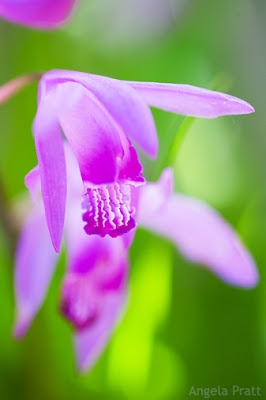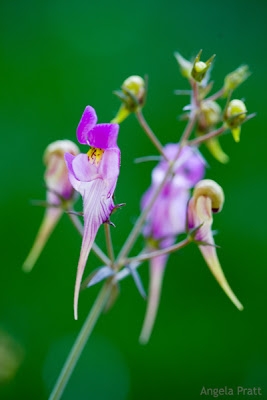by angela@diggingbliss | May 14, 2007 | Uncategorized
I’m sitting on my patio in a comfy but plastic Adirondack chair that will leave a chalky white film on my butt when I get up. Hey, they were only 20 bucks each and seemed like a good deal at the time. It’s 7:22 pm, sun is setting, the temperature feels like 72 degrees of perfection. The garden is absolutely still except for the movement of a few bees (yes, bees), ants and at this very moment, a hummingbird. An owl is hooting in the nearby park. Two yellow-billed magpies are carrying on a conversation from separate trees.
My laptop is propped precariously on my crossed legs, my Sennheiser PX100 headphones (a very good value, I might add) are delivering ‘Darlin’ Do Not Fear’ by Brett Dennen while the sun sets.
When I look to the left, I see a 4 1/2 foot tall coral-flowered Phygelius a friend gave me for my birthday last year that’s about to bloom for the first time. Other bloomers as I survey the yard include: lavender, penstemon, columbine, orchid cactus, abutilon, verbena bonariensis, roses, salvia, California bush anemone, wallflower, coral bells, lamium, cerinthe, California poppy, million bells, kangaroo paws, ‘Get Mee’ campanula, etc. Lilies planted in the last couple years in the ground and in pots are tall, budded stalks about to put on a big show.
Winter cold wiped out my beloved bush echium, Mexican bush sage, and nearly all of my hopseeds. A few weeks ago, the gaps and overall scorched earth vibe in the backyard made me want to go plant shopping. I’m glad I waited because I would have definitely over-planted. Now I see that the daylilies, veronica, agapanthus, penstemon, butterfly bush, and other warm-weather plants are really taking off and filling in those gaps. I still need to add some fillers, but not nearly as many as I thought.
I mowed and edged the lawn… yes, on Mother’s Day… and yes, my teenage son was supposed to have done it last week. I got tired of asking. He did compliment my work and even admitted the lawn looked better than when he mows it. I offered to show him my technique.
Last week, I planted tomatoes and basil. Let’s see… tomatoes were ‘Sungold’, ‘Early Girl’ and ‘Heatwave’. One more… an heirloom… should be plenty for me this year. The basil plants are Genovese and they’re being protected from snails quite successfully by Plant Defenders. Oh, and I put in three ‘Anaheim’ peppers. I will start some ‘Gold Rush’ yellow zucchini this week from seed. They’re delicious and excellent producers. Like I even need to mention that about zucchini. I’m not going to go nuts with the veggies this year. I tend to overplant. For some reason, I’m finding it easier than usual to avoid frantic overplanting. I think it’s the yoga. It mellows me out and the effect is somewhat residual.
I plan to replace my dead hopseeds with more hopseeds, but purple ones this time. Bronzy purple foliage adds such drama to the garden. Speaking of drama, my ‘Tropicana’ cannas are about 2 1/2 feet high after dying back completely to the ground over winter.
Ok, I just saw a mosquito. Time to go in. Somebody’s barbecuing steak. I wish my blog had smellevision. Goodnight from my northern California backyard. As I log off, The Staple Singers are singing ‘I’ll Take You There.’
I’ll post some flower pics soon. It’d be a crime not to.
by angela@diggingbliss | May 13, 2007 | Uncategorized
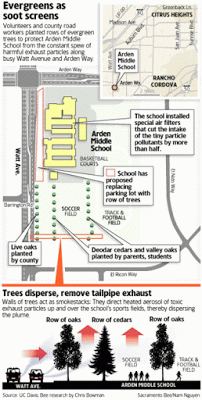
By Chris Bowman – Bee Staff Writer
Last Updated 12:18 am PDT Saturday, May 12, 2007
Story appeared in METRO section, Page B1
This is a great idea. For years, I’ve wondered about the air quality at Arden Middle School. In fact, I decided to take it out of the running as a potential middle school for my son because of my own (usually overprotective) air-quality concerns. Back then it was just a hunch. Now the high concentration of particulate pollution at the school has been verified, quantified and they’re working on an arboreal solution. Yay trees!
This school is located on the corner of Watt Avenue and Arden Way in Sacramento, CA. Arden is a fairly busy street, but Watt is a multi-lane major thoroughfare for neighborhood traffic and cars and trucks getting off and on Highways 50 and 80. Plus, the light at the intersection of Watt and Arden is a long one, which means lots of idling cars followed by accelerating cars. All day long. Cough, cough, choke, choke. I’m surprised those kids aren’t walking around with oxygen tanks, hunched over like longtime pack-a-day smokers.
I applaud the efforts to improve school grounds air quality by planting a tree buffer. I just wish they’d consider greater tree diversity. Another Bee article stated that redwood trees were tops at intercepting auto exhaust. I wonder why only oaks and cedars were planted. I’d also like to point out the obvious aesthetic benefits of planting trees at the school. Arden being a very tree-oriented neighborhood, I’m surprised they weren’t planted sooner for beautification reasons… and to give the kids some shade. Is it because of safety and maintenance issues? Dunno, but I’m glad to see this much-needed buffer being installed.
by angela@diggingbliss | May 11, 2007 | Uncategorized
Probe of tomato board pushed
By Dennis Pollock – Fresno Bee
Published 12:00 am PDT Friday, May 11, 2007
Story appeared in BUSINESS section, Page D1
by angela@diggingbliss | May 9, 2007 | Uncategorized
“MaMo” addresses the bee problem, AKA Colony Collapse Disorder, in today’s column, with humor, as he often does. So if you like your bitter news with a dose of honey…
Apocalypse Of The Honeybees – How poetically appropriate that the End of Man should come from such a tiny, sweet source Mark Morford, SfGate.com, 05/09/07
What can you do that might help bring back the bees? Yes, it’s entirely possible bee populations will rebound without our help, but there’s no harm in helping now, especially considering scientists are still stumped by the massive die-offs. We’re hearing possible culprits include pesticides, GMOs, cell phones, parasites, mites, fungi, and Ashlee Simpson. In the meantime, think about doing your part:
— Garden organically and practice Integrated Pest Management in your own backyard.
— Buy organic.
— Throw away your cell phone. Kidding! I hope.
— Boycott GMO crops.
— Support organizations working to help the bees.
— Elect environmentally-aware representatives.
— Plant bee-attracting flowers: bee balm, lavender, salvia, zinnia, natives, etc.
— Put up a bee house (see below).
— Hug a scientist. Better yet, donate to your local college’s entomology department.
by angela@diggingbliss | May 4, 2007 | Uncategorized
Sometimes I come somewhat grudgingly back to gardening after a long, wet winter. I’m like a teenager… like my teenager… who keeps pushing the snooze button on a school day. Only it’s not a school bell looming over me, it’s weeds. And drought. And a lawn that could swallow my short-legged dogs if I’m not careful. The fact of the matter is that I’m a lazy slacker of a gardener.
I hate weeding. I hate mulching. I hate feeding. I love planting. I love shopping for plants. I love deadheading, but not major pruning. I love watering with a hose, but hate hooking up drip systems. I really love photographing flowers. Yes, I earned a degree in horticulture from a respectable university, but most days it looks like I attended the Fickle Princess School of Mood Gardening. Not moon gardening, mood gardening.
If I’m in one of those magical moods which, perhaps not coincidentally, coincide with days when I’m well rested and sufficiently caffeinated, I can haul ass in the garden. Other times… ok, most of the time… gardening consists of watching weeds reach flowering stage, watching flowers wilt, and watching my dogs disappear into the lawn. This does bring on feelings of guilt and distress and inadequacy… and I usually respond by performing some hideous but tiny gardening task. Reactively, not proactively, I might add.
But today, I got a rain check. I don’t have to tackle the weeds in my veggie beds. Can’t find the damn hula hoe anyway. It probably hula’d its way over to a more worthy garden. As for me, I’ve got to scuffle off to yoga class. Believe me, I need it. Looming garden chores really stress me out. Namaste. I believe that translates to “Yours in sloth”.
by angela@diggingbliss | May 1, 2007 | Uncategorized
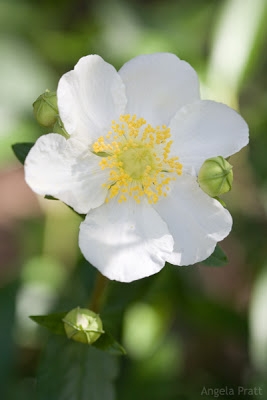
California bush anemone (Carpenteria californica)
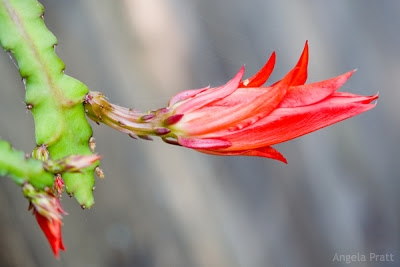
Red orchid cactus
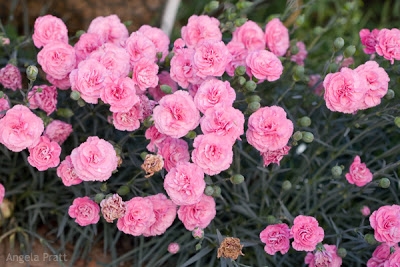
Dianthus hybrid ‘Devon Cottage Rosie Cheeks’… very prolific bloomer
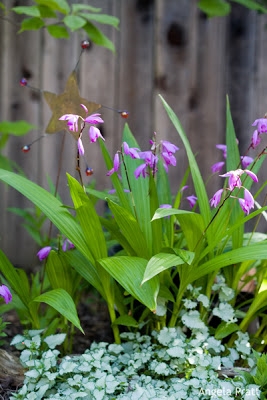
Chinese ground orchids and lamium

Purple Million Bells
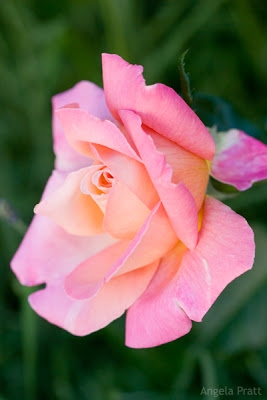
‘Chicago Peace’ rose
by angela@diggingbliss | Apr 30, 2007 | Uncategorized
Linaria triornithophora
“Three Birds Flying”
This was one of my impulse purchases at the Annie’s Annuals booth at the 2007 San Francisco Flower & Garden Show. I stuck it in a pot and it’s just beginning to bloom. Isn’t it amazing? At this stage, it looks more like Two Birds Sleeping and Two Birds About to Fly, but I’ll keep looking for the three flying birds. Maybe it’s like one of those optical illusion drawings that you have to stare at for a long time without blinking, when all-of-a-sudden dolphins appear. Now that I think about it, who cares about three birds flying. I’m going for the hidden dolphins!
by angela@diggingbliss | Apr 24, 2007 | Uncategorized
Have you seen this new offering from
Proven Winners? Hubba hubba!
Osteospermum ‘Sunny Sheila’
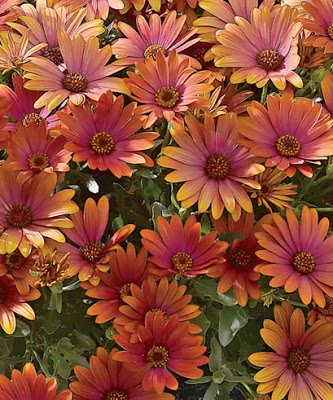
(Photo from Proven Winners website)
I indulged in a single one-gallon specimen this afternoon. Yes, it’s just an African daisy… but what a daisy. Coppery… irridescent… pinky… hints of yellow. It’s catch-your-breath gorgeous, especially when lit by late afternoon sun.
by angela@diggingbliss | Apr 21, 2007 | Uncategorized
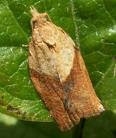
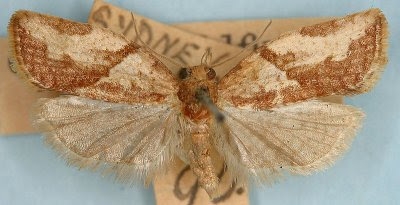
(Photos from the California Department of Food & Agriculture website)
Here’s a snippet from the CDFA profile:
Background
This moth is originally from Australia, and has become established in New Zealand, New Caledonia, Hawaii and the British Isles. Its discovery in California is a new North American record.
Hosts
LBAM has been recorded from over 200 plants in 120 plant genera in 50 families. Some notable trees are apple, pear, peach, apricot, nectarine, citrus, persimmon, cherry, almond, avocado, oak, willow, walnut, poplar, cottonwood, coast redwood, pine, and eucalyptus. Some common shrub and herbaceous hosts are grape, kiwifruit, strawberry, berries (blackberry, blueberry, boysenberry, raspberry), corn, pepper, tomato, pumpkin, beans, cabbage, carrot, alfalfa, rose, camellia, jasmine, chrysanthemum, clover, and plantain.
http://www.cdfa.ca.gov/phpps/pdep/lbam_main.htm
If you see this moth, contact your local County Agriculture Commissioner’s Office.

by angela@diggingbliss | Apr 16, 2007 | Uncategorized
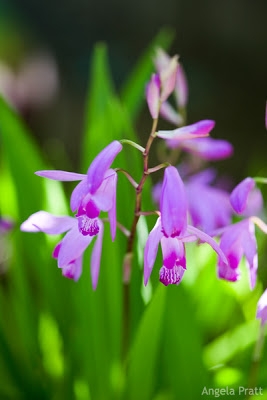
For “Snappy” (David) to show to his potted Bletilla babies.
